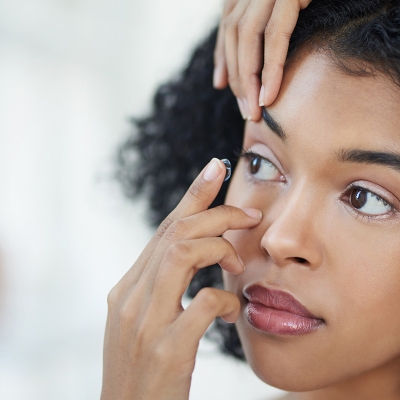Spot the signs of these 3 eye problems
Glaucoma, cataracts and macular degeneration can rob you of your eyesight but detecting them early can help stop that. Find out what the signs are and what to do about them.

This article is part of UnitedHealthcare Vision’s Healthy Vision Challenge. Taking care of your eyes is critical to your overall health and wellness. It’s smart to be thinking about the quality of your vision all the time, not just when your eyes are bothering you or your experiencing changes. If you can make these behaviors part of your everyday routine, you could have healthier eyes for life.
Imagine going through your day without being able to see clearly. Things might look blurry or dim, as if the lights were always turned down low or maybe everything would look wavy when you stared straight ahead.
That’s the reality for 4.2 million Americans ages 40 and older who are visually impaired, according to the Centers for Disease Control and Prevention.1 That means they have some sort of vision loss, which may make it tough to do normal activities, such as driving or reading. More than three-fourths — or 3.3 million — of those folks are ages 60 and older and that number is expected to double to 6.6 million by 2050.2
There are all sorts of eye conditions that can damage your eyesight, but three major conditions are cataracts, glaucoma and age-related macular degeneration (AMD). Each of them can cause you to go blind — slowly. “These eye diseases don’t happen overnight. They’re progressive conditions,” says Jen Wademan, O.D., an optometrist in Folsom, California.
By learning how to recognize symptoms and getting your eyes checked annually, even if your vision is 20/20, you can detect these diseases early, which can help save your eyesight. If you’re over 65, have a family history of eye diseases such as glaucoma, or simply wear glasses or contacts, you may need to get checked more often.3
Even if you’re getting yearly checkups, tell your vision provider about any changes you’ve noticed. Here’s how to spot the signs of each of these eye diseases and get them treated early on.
Stay on top of your eye health with an in-network provider. Search for an eye care provider now.
Cataracts
These are a slow-growing cloudy film on the lens of one or both eyes. Your risk of developing cataracts goes up as you get older. “Just like wrinkles and gray hair, if you live long enough, you’ll develop a cataract,” says Angelica Cifuentes, O.D., an optometrist in Miami. In fact, more than half of Americans ages 80 and up have (or had) cataracts.4
What are the signs?
- Your vision gradually blurs or dims.
- You have trouble driving at night because it’s hard to see.
- Colors look faded or dim.
- Car headlights and sunlight are too bright, or you see halos around headlights.
How they’re treated: By making some everyday changes early on, such as using antiglare sunglasses when you drive or getting stronger glasses or contacts. If it’s too tough for you to watch TV, drive or work, your eye doctor may recommend surgery to remove the cataract. You’ll get new, artificial lenses and you’ll be able to see more clearly.
Glaucoma
This is a group of diseases of the optic nerve. The optic nerve is a bundle of nerves connecting the back of the eye to the brain. It sends messages from the eye to the brain so you can see. No one knows what causes glaucoma, but experts think it might be a buildup of fluid in the eye that puts pressure on the optic nerve.5 Over time, the pressure damages the optic nerve and causes blindness.
What are the symptoms?
- Usually none at first. “Most people won’t know they have glaucoma unless they are going in for a routine eye exam, where glaucoma is one of the things we screen for,” says Cifuentes.
- When it’s more advanced, you’ll gradually begin to lose your side vision. As it progresses, you might not be able to see anything off to the side.
How it’s treated: Glaucoma can’t be reversed, so the goal is to stop the damage to keep the vision you have left. That’s usually done with eye drops that lower the pressure in your eye. If eye drops don’t work, then doctors may try oral medication, laser treatments or surgery to drain the fluid.
Age-related macular degeneration
AMD damages the macula, the part of the eye in the center of the retina. The macula receives all the images that are straight in front of you in the sharpest detail and keeps them that way. There are several risk factors for AMD. Getting older is one — and you can’t stop that, but so are smoking and high blood pressure, which are under your control.6
What are the symptoms?
- “If straight lines appear wavy, we know there may be something going on with the macula,” says Cifuentes.
- A blurry or blank spot when you look straight ahead
- Colors don’t look as bright
- Trouble seeing in dim light
How it’s treated:
It depends on the stage.
- In its earliest stages, regular eye exams are important. Eating a heart- and eye-healthy diet and staying active can help slow AMD down.
- If AMD does progress, taking the supplement AREDS 2 may help stop it from turning into severe AMD.7
- Your doctor may inject drugs called anti-VEGFs into the eye or use laser treatments combined with the shots. This treatment depends on the type of AMD you have.8
Most of these diseases are caught by your eye doctor. That’s why getting regular eye checkups is so important. “We can be more proactive if we know your vision history,” says Wademan.
The same is true of any changes that the optometrist catches. “We can start treatment a lot sooner,” Wademan notes, which can go a long way toward keeping your eyesight — and your quality of life.
Looking for a new eye care provider? Search the UnitedHealthcare Vision Network now.
Sources:
- Fast Facts About Vision Loss Centers for Disease Control and Prevention, last reviewed December 2022.
- Vision Impairment Has Implications for Aging and Health Outcomes, Beyond Ophthalmology JAMA Network Open, May 2022.
- New AOA Adult Eye Guideline Offers 14 Actions, Provides Fresh Insight on Exam Frequency American Optometric Association, March 2023.
- Cataracts National Eye Institute, updated January 2023.
- Glaucoma and Eye Pressure National Eye Institute, updated March 2022.
- Risk Factors for Macular Degeneration American Macular Degeneration Foundation
- AREDS 2 Supplements for Age-Related Macular Degeneration (AMD) National Eye Institute, updated June 2021.
- Age Related Macular Degeneration National Eye Institute, updated June 2021.


